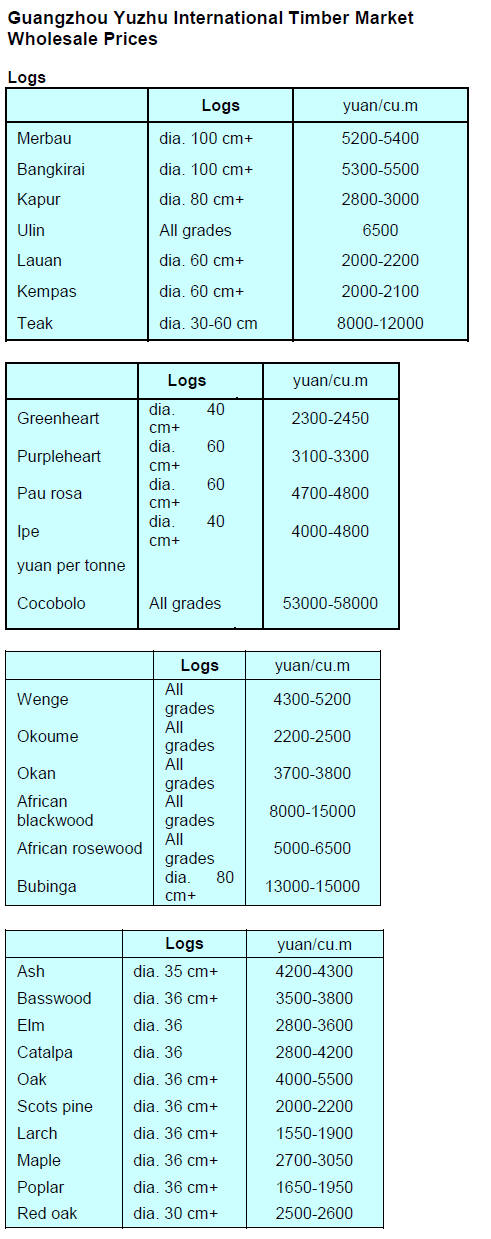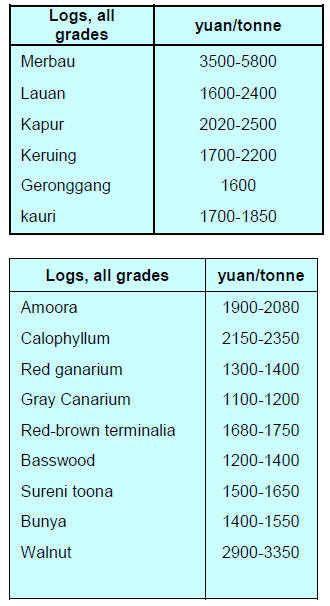US Dollar Exchange Rates of
10th April 2015
China Yuan 6.2083
Report from China
China halts timber imports from 3 countries
On 8 April China‟s National Endangered Species Office
issued a directive suspending imports of CITES listed
timber species (Pericopsis elata) and (Dalbergia
cochinchinensis) from the Democratic Republic of Congo
(DRC) and Laos.
The Office reminded timber importers not import CITES
listed timber from the two countries until the restriction is
lifted.
This restriction follows a directive from CITES Secretariat
recommending all signatory countries to suspend trade in
CITES-listed species from the DRC, the Lao People‟s
Democratic Republic and Nigeria until further notice due
to the failure of these three countries to submit a National
Ivory Action Plan.
For more see:
http://www.cites.gov.cn/ShowIndex/ShowNews.aspx?id=1
89&sort=t2
and
http://www.fws.gov/le/pdf/3-19-2015-Elephant-NIAPTrade-
Restrictions%20(1).pdf
National timber tracking system implemented
The China Timber and Wood Products Distribution
Association (CTWPDA) has announced that a National
tracking, inspection and labelling system for wood
products has been officially launched and that certificates
of compliance have been issued to some enterprises using
the system.
The CTWPDA says the purpose of the new system is to
guide the management integrity of domestic enterprises, to
build a unified traceability system, expand brand
awareness for the participating enterprises, help eliminate
counterfeit products and protect the rights and interests of
legitimate operators and consumers.
The National Wood Products Traceable Information
Management System has been jointly established by the
China Timber and Wood Products Distribution
Association and domestic research institutions. Details of
the tracking certificates which have been issued to the
participating enterprises can be found on the CTWPDA
website which at present is only in Chinese.
The National Wood Products Traceable Information
Management System covers wood-based panels, flooring,
wooden doors, furniture, engineered wood, treated logs
and redwood products.
See:http://www.cnwood.org, National CXBZ Inquiry
System http://www.cxbz.org/
and
http://321.chinaso.com/chaxun
CPWPDA suggests tax cut on flooring
The CTWPDA has submitted a recommendation for a
reduction in taxes on flooring manufacturers to the
Ministry of Commerce, the National Development and
Reform Commission and the State Administration of
Taxation.
The CTWPDA suggests policies need to be formulated to
encourage timber utilisation in the flooring industry and
that these policies should include a tax cut on solid wood
flooring and wood composite flooring. The CTWPDA also
called for elimination of taxes on wood composite flooring
and solid finger-joint flooring manufactured from residues
and non-log raw materials such as wood waste as well as
plantation timbers.
A similar recommendation was submitted in 2012 and in
2013. The CTWPDA argues that a change in tax structure
will assist the wood flooring sector to become more
dynamic and could accelerate the adjustment of the
structure of the sector, promote economic development,
assist enterprises cope with unfavorable unstable market
demand and achieve further development of the flooring
industry.
Trends in China¡¯s wood-based panel industry
In recent years there has been a marked slowdown in the
pace of growth in China‟s wood-based panel industry. The
output of wood-based panels in 2014 rose 11% to 300
million cubic metres but the pace of growth was well
below the 20% level a year earlier.
Statistics suggest there are more than 10,000 wood-based
panel enterprises in China employing around 3 million.
Private enterprises dominate the wood based panel sector
providing employment to approx. 2.3 million workers.
Most plants are small with an annual capacity of no more
than 10,000 cubic metres of output.
There are around 1,200 fibreboard production lines with
more than 300,000 employees and around 1,400
particleboard plants. The pace of growth of particleboard
output was the fastest in 2014.
Distribution of wood-based panel enterprises
There are 8 provinces where production of wood based
panels exceeds 10 million cubic metres annually. Six
provinces: Shandong (64.22 million cu.m), Jiangsu (44.64
million cu.m), Guangxi (29.70 million cu.m), Anhui
(18.42 million cu.m), Henan (15.81 million cu.m) and
Hebei (14.95 million cu.m) account for approximately
73% of national wood based panel production.
Foreign trade in China¡¯s wood-based panels
Imports
China‟s 2014 plywood imports totalled 180,000 cubic
metres valued at US$132 million, up 15% in volume and
28% in value. The average price for imported plywood
was US$741 per cubic metre.
In both volume and value China‟s fibreboard imports rose
dramatically in 2014. China‟s fibreboard imports
amounted to 220,000 cubic metres valued at US$110
million, up 223% in volume and 132% in value. The
average price for imported fibreboard was US$500 per
cubic meter.
China‟s 2014 particleboard imports totalled 580,000 cubic
metres valued at US$142 million, down 1.5% in volume
but up 11% in value. The average price for imported
particleboard was US$243 per cubic metre.
Exports
China‟s plywood exports in 2014 totalled 13.22 million
cubic metres valued at US$5.814 billion, up 29% in
volume and 16% in value. The average price for exported
plywood was US$410 per cubic meter.
China‟s 2104 fibreboard exports amounted to 3.41 million
cubic metres valued at US$1.631 billion, up 46% in
volume and 38% in value and the average price for
exported fibreboard was US$479 per cubic metre.
China‟s particleboard exports totalled 380, 000 cubic
metres valued at US$139 million, up 45% in volume and
up 57% in value. The average price for exported
particleboard was US$366 per cubic metre.
The future for China¡¯s wood-based panel industry
According to the plan set out for China‟s forest products
industry in the thirteenth 5 year plan the sector be
transformed and upgraded with a new environmental
outlook and will enter a new phase of development.
The sector will be directed towards:
 Expanding the raw material base and
gradually Expanding the raw material base and
gradually
realising the integration of forestry and panel
production.
 Accelerating the pace of
technological progress, Accelerating the pace of
technological progress,
gradually elimination of outdated production
methods, optimising the product range with a
focus on demand for structural panels.
 Accelerating consolidation in the
industry and Accelerating consolidation in the
industry and
elimination of closure of enterprises.
 Establishing specialised industry
clusters to Establishing specialised industry
clusters to
improve efficiency and reduce costs.
 Improving the quality of wood-based
panels Improving the quality of wood-based
panels
through adopting advanced technology, new
materials and new equipment.
 Strengthening social
responsibility. Strengthening social
responsibility.
 Building brand awareness. Building brand awareness.
and
 Expanding utilisation of urban wood
waste and Expanding utilisation of urban wood
waste and
recycling.
 
 
|